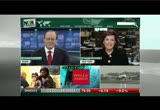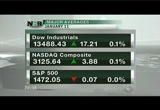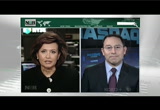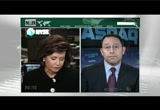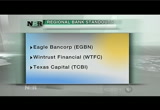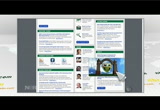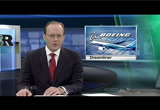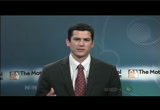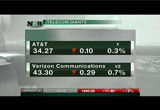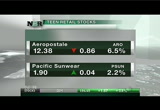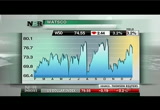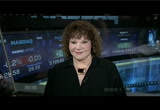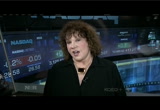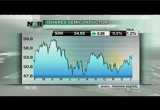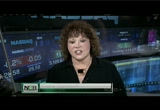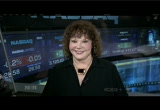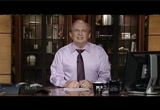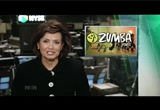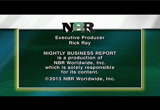tv Nightly Business Report PBS January 11, 2013 6:30pm-7:00pm PST
6:30 pm
captioning sponsored by wpbt >> this is n.b.r. >> tom: good evening. i'm tom hudson. it's one of the worst flu seasons in a decade. how all those sick days could impact a company's bottom line and the economy. >> susie: i'm susie gharib. wells fargo posts better than expected earnings. we review the results and pre- view a wave of big bank earnings coming out next week. >> tom: and boeing's 787 dreamliner undergoes a comprehensive safety review by federal regulators af(oqr severl problems surfaced this week. that and more tonight on "n.b.r." >> tom: if you are sneezing andç feverish tonight, you're not alone. the flu has officially reached epidemic proportions in the united states.
6:31 pm
the centers for disease control and prevention say more than 7% of deaths last week were caused by pneumonia and the flu. it's expected to be the worst flu season in a decade. but it's not just a public health issue, there's the potential for a real economic impact, costing employers billions of dollars. erika miller reports. >> reporter: hospitals like montefiore medical center in the bronx are reporting big spikes in flu cases. here, as many as 40% of people seeking emergency care have flu symptoms. >> in our pediatric emergency room, we are seeing in the range of 200 patients a day. and at that point, it's difficult to manage with all the staff that we have and the rooms that we have. >> reporter: the situation has gotten so bad in the big apple, that it's new nickname is "flu york city." but many other places are getting slammed by the flu, too. as this map from the centers for disease control shows-- the epidemic is widespread across the nation. unfortunately, the flu's early arrival, and this year's
6:32 pm
particularly nasty strain, are creating shortages of the tamiflu treatment, as well as flu vaccines in some areas. on average, seasonal flu outbreaks cost u.s. employers $10.4 billion in healthcare costs, according to the centers for disease control. but this year is expected to be far worse. that figure does not include the cost of lost worker productivity. >> reporter: to make matters worse, many employees are reluctant to call in sick, for fear of losing their jobs. so they continue going to work, delaying their recovery and infecting others. some businesses have so many sick workers. they're severely understaffed and are scrambling for back-up plans. >> it's a perfect storm. companies are already quite lean in terms of their abilities to duplicate work if somebody is out. and this year's flu season isç three times what the normal levels are for flu. >> reporter: doctors also have some recommendations forç companies trying minimize the impact of the flu on theirç workforce.
6:33 pm
>> if your employee is sick, they should stay home. you should recommend that your employees get the influenza vaccine, if they haven't done so already. >> reporter: and that's advice i personally took to heart today. erika miller, "n.b.r.," the bronx. >> tom: the u.s. trade gap grew unexpectedly in november. it went up 16% to about $49 billion.xd the news is bittersweet. the gap grew thanks to an increase in demand for consumer imports like apple's iphone 5. we heard some dissention inside the federal reserve. the head of the philadelphia fed charles plosser said the central bank's policy of buying bonds is risky. but it was a mild day for wall street. the dow gained 17. the nasdaq added almost four points. the s&p lost a fraction. and for the first full trading week of the year, both the dow and s&p gained half a percent. the nasdaq ticked up nearly 1%.
6:34 pm
>> susie: investors were preoccupied tod! with wells fargo. the first big u.s. bank to report earnings. even though its results came in better than expected. investors were concerned by slower loan growth and how much money the bank makes on those loans. the so-called net interest margin declined more thanç expected. wells earned 92 cents, three cents more than estimates. revenues also came in higher than expected: up 6.5% to almost $22 billion. but the stock fell less than 1% to about $35. joining us now, joshua siegel, founder of stone castle partners, a new york investment firm that specializes in banks. josh, welcome to the program, thanks for coming. some disappointment about that slowdown in mortgages at mortgage lending, and mortgage applications at wells fargo. what does this mean for profits going forward at wells?
6:35 pm
>> well, it really depends on your view of mortgage product. with rates as low as they are, and if they stay low, there's only so much refinancing that can occur. if you have a view that mortgage lending will pick up, not just maintain, but pick up, you have a bullish view on the stock. if you think tell maintain or slow down which we've seen in the last quarter, it puts a little bit of pressure on the earnings in the coming quarter. >> susie: there certainly was pressure on bank stocks today. and next week we have a bunch of big bank that is are going to be reporting. let's look at the calendar. j.p. morgan reporting wednesday as well as goldman sachs, and then thursday, bank of america and citi. what do you think is going to be the theme of these banks reporting besides mortgages? >> i think the theme is going to be one time. even if wells fargo, there was a number of one time events. private equity gains. gains on securities. there were -- if we take out
6:36 pm
the 10 billion of mortgage production kept on the balance sheet, it would affect the growth. and no better or worse than last year. wheny woo look at the other majors the theme is where does growth come from? wells fargo being the nation's largest home lender would benefit the post from mortgage refinancing. and less for the other majors. i think the theme is traditional banking remains under pressure. you have net interest margins that will compress. generally, i don't see anything that will produce upside in the coming quarters. >> susie: one area that has been resolved earlier this week, the settlement on that robo signing deal. so that is off the table so that these banks can now focus more on the future. >> right. >> susie: what kind of year do you think 2013 will be for the banks? do you think more positive or
6:37 pm
more negative? >> well, there's a mixed question there. if it's stock performance, i think we've seen most of the upside potential priced in. with wells down today slightly, even though it has a quarter of record earnings. i think what the market is telling us is even though wells's execution was probably perfect, they've already priced in any upside in the market, and won't have a lot of upside. i think the year for stocks will probably be average. when we get into smaller banks that have more potential to be tactical. more upside for the regional and spaurl banks, not as much for the large barngs. >> susie: talk about that. your firm can favor the smaller regionals. and less interested in the big banks. quickly, we have little time left. you talked about wind trust financial, texas capital. why do you think those? what's the unifying theme
6:38 pm
between these companies? >> the unifying theme is that we're tactical. being a smaller bank, and the banks you just mentioned from a few billion to 15 or 20 billion in assets. they not only have room to grow geographically, but in specific markets experiencing growth, rather than when you're a a trillion or 2 trillion, you're playing the whole nation. and local, you can be specific on certain types of lending to achieve and focus efforts on the market. with those three different platforms, they've had a fantastic year, and outperformed the market. and i think that trend will continue through 2013. smaller banks will likely do better. >> susie: very interesting analysis. pressure having you on the program. joshua siegel, stone castle partners. for more going to nbr for more on banks, go to nbr.com to hear from a financial expert on what it takes to fix the financial system: just look for the nbr-u tab to see "good banks bad banks and the government's role as a fixer". >> tom: royal bank of scotland
6:39 pm
is expected to be the latest bank to pay big fines for it's alleged part in a global interest rate rigging scandal. libor is a key lending rate that affects everything from student loans to home mortgages. no details yet on the size of the payout or when the amount will be determined. two banks have paid fines. >> tom: boeing's dreamliner jet remains in service tonight even as federal regulators have opened a top to bottom review of the plane. the federal aviation administration announced the safety review after at least four separate incidents with the new planes this week, problems
6:40 pm
that have shaken the confidence of some shareholders. >> reporter: this is the most recent problem for boeing's newest and most complex aircraft, a cracked windshield on a 787 in japan today. but it was problems earlier this week like an auxiliary battery fire on board an empty 787 in boston that got the attention of safety regulators. >> this review will cover the critical systems of the aircraft including the design, manufacturing and assembly. >> reporter: the action comes 15 months after the dreamliner was cleared for take-off by regulators and came into service. the plane had been eagerly anticipated by the airline industry. it uses lightweight carbon composite material more than other passenger planes. it also relies more on electrical systems instead of mechanical components. the result is a lighter plane allowing it to be more fuel efficient. 50 of the planes are currently in service and can remain flying during the safety review. more than 800 of them have been ordered by air carriers across the globe.
6:41 pm
>> we have complete confidence in our production system and production plans and the manufacturing process that goes with it as well as the design. >> reporter: today's announcement was unusual in that boeing, the subject of the review was present along with its regulators, who echoed boeing's confidence in the safety of the plane. >> i believe this plan is safe and i would have absolutely no reservation of boarding one of the these planes and taking a flight. these planes are safe. >> reporter: it has been a rocky ride this week for boeing shareholders, moving at least 1.5% in four of the past five sessions. it was down 2.5% today. >> i believe this plane was the next big thing, a game changing engineer feat. and the success of boeing if you're looking at the stock, looking at the company, the dreamliner is closely attached to that i believe. >> tom: the dreamliner was three years late coming to market, really changing the way planes are built. major sectors of the plane are built in asia, europe and the
6:42 pm
u.s., before final assembly outside of seattle. still ahead, more than 14 million people in 150 countries take a zumba class every week. we'll take a look at the business behind the exercise craze with the company's c.e.o. >> susie: "disappointing." that's what the judge handling kodak's bankruptcy called the final sale price for the photo giant's digital-imaging patents. but he approved the $527 million sale anyway. it's much less than the $2 billion kodak wanted. the buyers are a group of tech giants, including apple, microsoft, google and adobe systems.t( since kodak went bankrupt nearly a year ago, it has shut down or sold off several divisions, including its consumer printing business.
6:43 pm
>> susie: there's a lot of factors that go into investors and market decisions that they make, and human emotion and sentiment is one of them. now a company is using the twitter platform to come out with a way to measure mue human emotion and sentiment in real-time. not sure about the technical how it works but it launches next week, and we'll be talking more >> tom: it's an interesting concept, one to watch. it starts in the u.k. and may come to the u.s. next month. it will be following 350 million tweets a day trying to gather up investor emotion when it comes to stocks, currency and emotions. there's a lot of emotion in the market. >> susie: absolutely. >> tom: little bit of emotion
6:44 pm
today, although not much movement overall for the major stock indices. kind of a quiet day finishing with mixed results. the s&p 500 traded most of the session in the red, as the market was not impressed with well fargo's quarterly results. it pulled into positive territory at the closing bell to end unchanged. trading volume was 632 million shares on the big board. just under 1.8 billion traded on the nasdaq. five sectors were up, five were down, but none of them made any significant moves.ç the telecommunications sector lost the most 0.4%. consumer staples led the gains with a small 0.3% rally. the telecommunications space has been under pressure all week, even as the two big wireless carriers, a.t.&t. and verizon reported strong smartphone sales over the holidays. a.t.&t. dropped a third of a percent today, while verizon fell 0.7%. verizon is off 2.5% already this year. best buy was in focus as holiday sales fell compared to a year earlier, but they didn't fall as much as feared.
6:45 pm
in wall street logic: that's good news. sales at best buys in the u.s. were flat, which was a surprise. shares jumped 16.4%. volume quadrupled with the stock closing at a two month high. but it wasn't all good news. best buy cut its free cash flow forecast as it faces earlier than expected payments to merchandise manufacturers. best buy's founder richard schluze continues looking for financial banking to fund a buy out of best buy. the cash flow at department store j.c. penney also came under scrutiny today. investment bank u.b.s. thinks the store will have to change its turnaround strategy to address cash flow worries brought on by company spending money on new shops. shares fell 4.7%. two specialty retailers were moving. teen clothing store aeropostale fell 6.5%. investment firm piper jaffray cut its rating from overweight to neutral, pointing to a disappointing holiday season. meantime pacific sunwear was shining up 2.1%. even though it warned about losing more money thanks to promotional discounts. instead, an analyst noted the
6:46 pm
company's profit margins have improved from a year ago. a lower financial forecast also hit global engineering first k.b.r. it warned its full year earnings will not be as strong as anticipated. it partly blames the disappointment on higher than expected labor costs. shares sank 7.9% on heavy volume. falling to a two week low. but ford motor is adding to its labor ranks. the auto maker announced it will hire 2,200 salaried workers this year. the job opportunities will be in manufacturing, technology and product development.ç shares continued to rally to new 18 month highs, up 1.2%. goldman sachs raised its rating, expecting a pick-up in pick-up sales in america. just yesterday ford announced it was doubling its quarterly shareholder dividend. watsco today cut its dividend, saying it will continue paying them, but on a more moderate basis. shares fell 3.2%. that big stock drop in october was after the company paid a special five dollar per share dividend. four of the five most actively traded exchange traded products were lower. the lone gainer was the japan index fund up 0.3%
6:47 pm
and that's tonight's market focus. >> tom: a year ago i described tonight's market monitor as quote, "a bull. plain and simple." and even as the stock market trades near five year highs, she is even more optimistic about higher stock prices today.ç elaine garzarelli is president of garzarelli capital. >> nice to see you. >> tom: a bull playing simple a year ago, and more optimistic today.
6:48 pm
are you more optimistic than a year ago, and why? >> well, i have 13 indicators in the stock market, and they're at 82%. anything below 30% would be a major sell signal or bear market signal, and below 42% would be a correction of 10 to 15%. so that's a very, very high level, and the indicators include monetary policy, economic cycles, sentiment and valuation. the valuation indicator is very bullish, suggesting a 10 to 15% gain in the market over the next year. >> tom: let's talk about that valuation part of the market here, because we're seeing the valuation with a backgroubd of tepid economic growth. how do you square those two? >> well, we see economic growth of two percent this year. the earnings gain will be modest. it will only be 5 to 6% per the s&p 500 operating earnings. that's a level of about 105. so give that a serveative pe
6:49 pm
ratio of 15 to 16 times and that gives us our 10 to 15% gain for the overall market. but if you get in the right sectors your gain could be twice that much. >> tom: and you brought those along, consumer discretionary being one of those sectors. xly ticker simmel exchange traded fund. you see more gains. >> i do. the reason is because consumer confidence has turned up, and we have lower oil prices and housing is doing very, very well. so this should bode well for this particular etf, and some of the stock markets in there would be home depot, disney, and ford. >> all household names, and you like semi-conductors. we've had a tough time over the past 12 months as folks looked at the traditional computer market going lower, and the big movement towards smart phones and tablets
6:50 pm
continue. >> well, we think there's a turnaround in technology this year. as a matter of fact, we have technology growing three times more than real gdp this year. so with the uncertainty of the fiscal cliff over, we see a real turnaround there, and semi-conductors are the most leveraged high data area of technology group. there we like broadcom, taiwan semi-conductor, texas instruments and intel. and that group is down 10% from its peak last year. it's very good value. >> tom: and you also like telecommunications equipment, and in the telecom sector gotten off to a rough start at the beginning of the year. what do you anticipate? >> that's why we love t. underperformed and down from the peak last week. extremely cheap, and we like the igni shares, and qualcomm, cisco, and juniper networks. >> tom: it has been a year
6:51 pm
since we spoke. you were a bull then, and you're a bull now. you like small caps, the russell 2000, up 14%. technology up 13 and a half, and the industrials up 10%. you still like these sectors at all? >> yes, i do. >> tom: would you put new money to work even though we've seen double digit gains from a year ago? >> i would, especially in the iwm, a small cap composite t. reached an all-time high a couple weeks ago. >> tom: are you a hundred percent invested in stocks at >> for my sector analysis fund i am a hundred percent investmented in stocks. >> tom: the funds we mentioned tonight, do you have positions in those? >> i have positions in all -- everything i mentioned tonight in the sector analysis fund, yes, i do. >> tom: eating your own cooking. elaine garzarelli back with us. president of garzarelli capital. >> susie: on monday, we continue our n.b.r.-u series.
6:52 pm
it's our partnership with some of the nation's top business schools. what should you do to fix your money market fund? we'll ask harvard's robert pozen. and we'll talk to volkswagen america c.e.o. jonathan browning from the north american international auto show. >> tom: at the beginning of every year we also see a lot of year end, best of lists. best movies, best stocks. when it comes to being successful, it's important to focus on doing your best, regardless of the task. this week lou's been thinking about coming out ahead. here's author and educator lou heckler. >> having earned a degree from the university of north carolina many years ago, i really have college basketball fever in my blood. i am endlessly fascinated with great coaches-- men's and women's-- and how they draw so much from their players. one of those i have admired for years is pat summitt. no longer actively coaching women's basketball at the university of tennessee because of early-onset alzheimers disease, her impact on the game remains profound. a few stats: 1,098 wins, 38 years as a head coach without a losing season, eight national
6:53 pm
championships. yikes! just as importantly, her athletes graduated. some went on to wnba careers and all of them learned what it took to be a winner on and off the court. she had a no miss, up front rule. that applied to the classroom and the basketball court. you don't miss practice just like you don't miss class. you position yourself up front because that's where you want to be your whole life. what if we had similar we all want to be up front, but have we created a climate where everyone knows what it takes to get there? tell them a little about pat. one of the key areas we all must do in business is coach other people. take a cue from one of the best coaches on the planet. i'm lou heckler. >> susie: for many people a new year means making new resolutions to get fit. for those who find the gym daunting, there's zumba. it's described as a dance party that doesn't feel like exercise. as ruben ramirez discovered, zumba's business model is all about getting people excited about fitness without using the "f" word. >> reporter: make no mistake. this isn't your typical dance
6:54 pm
class, you're expected to sweat a lot and follow the choreographed dance moves. it's what zumba c.e.o. alberto perlman calls a fitness concert. >> we want to take this on the road. we want to take this to vegas. why not exercise while you're in vegas at night, or a standing show in new york, we want to have these shows go on tour. >> reporter: it's the latest idea from the creators of the zumba empire, which includes everything from d.v.d.s to video games and a clothing line. but perhaps the empire's biggest winner is the music business. >> we really like working with pitbull. he was the first one to see that we have a 14 million people taking classes every single week station and i can promote my music through you guys and those 14 million people can not change the dial. of those 14 million people in zumba classes, half are in the u.s. >> reporter: the company started a decade ago when perlman met beto perez. >> it was that ah-ha moment
6:55 pm
where the entrepreneur in me said, this needs to be scaled. >> reporter: and scale it has. it's been called the zumba economy. edmee cherdieu dalexis has been teaching zumba for four years. today, she co-owns five zumba studios around new york city. >> what i wanted to bring to the new yorker was quality. the best of the best zumba classes they could take. >> reporter: so, what's it take to be a zumba instructor. the license costs $300 and its $30 a month for the music and the choreography. perlman says instructors are the secret sauce to success with more than 100,000 and counting. >> it's the business model of empowering people to participatç in your business. >> reporter: that relationship is a mutual moneymaker. >> it's only been two years and its only now that were almost breaking even but compared to where we started, which was zero to where we are now i feel confident that were going to stay in business and were going to keep on spreading it.
6:56 pm
>> reporter: and if you thought it's just a craze, experts say it gives participants a better workout than kickboxing, step and even pilates. ruben ramirez, nbr, new york >> susie: that's "nightly business report" for friday, january 11. have a great weekend everyone and you, too, tom. >> tom: goodnight, susie. we'll see you online at nbr.com and back here next week. captioning sponsored by wpbt captioned by media access group at wgbh access.wgbh.org
231 Views
Uploaded by TV Archive on

 Live Music Archive
Live Music Archive Librivox Free Audio
Librivox Free Audio Metropolitan Museum
Metropolitan Museum Cleveland Museum of Art
Cleveland Museum of Art Internet Arcade
Internet Arcade Console Living Room
Console Living Room Books to Borrow
Books to Borrow Open Library
Open Library TV News
TV News Understanding 9/11
Understanding 9/11
